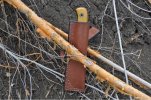-
The BladeForums.com 2024 Traditional Knife is ready to order! See this thread for details: https://www.bladeforums.com/threads/bladeforums-2024-traditional-knife.2003187/
Price is$300$250 ea (shipped within CONUS). If you live outside the US, I will contact you after your order for extra shipping charges.
Order here: https://www.bladeforums.com/help/2024-traditional/ - Order as many as you like, we have plenty.
You are using an out of date browser. It may not display this or other websites correctly.
You should upgrade or use an alternative browser.
You should upgrade or use an alternative browser.
The Chronicles of Fiddleback
- Thread starter gumaropa
- Start date
Dear fiddle-backers; first of all Happy Easter to all.
It looks like Andy has been busy making Osage Orange versions of his knives as of late, so I wanted to shown you what the actual tree looks like in nature.
The easiest way to find and Osage Orange is to look for the roots along the ground. The roots are orange, and have a paper-like coating which is yellow and orange. It is my understanding that you can peel these layers and add to water to make a dye.
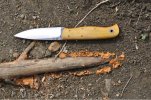
Then, there is the wood, which as we know ranges from yellow to orange to brown. Here is an example of a branch that was cut and has been exposed for a while. The younger wood tends to be more yellow in color as seen here.
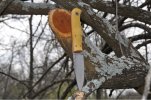
The trees are about to sprout leaves around here, so you can see some twigs with the characteristic thorns (Thurin, you are not the only one with a Spydie, and from the looks of Dylan's post, the workshop is crawling with them too!). I tend to like mine serrated...

Lastly, I could not resist adding two additional pictures to showcase Andy's work. The "spider nest" is actually a caterpillar nest.
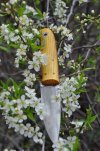
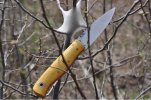
Enjoy!
G
It looks like Andy has been busy making Osage Orange versions of his knives as of late, so I wanted to shown you what the actual tree looks like in nature.
The easiest way to find and Osage Orange is to look for the roots along the ground. The roots are orange, and have a paper-like coating which is yellow and orange. It is my understanding that you can peel these layers and add to water to make a dye.

Then, there is the wood, which as we know ranges from yellow to orange to brown. Here is an example of a branch that was cut and has been exposed for a while. The younger wood tends to be more yellow in color as seen here.

The trees are about to sprout leaves around here, so you can see some twigs with the characteristic thorns (Thurin, you are not the only one with a Spydie, and from the looks of Dylan's post, the workshop is crawling with them too!). I tend to like mine serrated...

Lastly, I could not resist adding two additional pictures to showcase Andy's work. The "spider nest" is actually a caterpillar nest.


Enjoy!
G
Last edited:
Mountain Wildman
Gold Member
- Joined
- Aug 29, 2010
- Messages
- 1,510
Very cool!!
So eventually the Osage scales will look like the dark center of the cut branch you pictured?
That sheds a whole new light on Osage since I usually prefer dark handles on knives.
Thanks for sharing,
Joseph
So eventually the Osage scales will look like the dark center of the cut branch you pictured?
That sheds a whole new light on Osage since I usually prefer dark handles on knives.
Thanks for sharing,
Joseph
- Joined
- Jan 6, 2005
- Messages
- 1,331
Osage will darken with age and use to a really rich root beer color. It's caused by exposure to sunlight. Cocabola does the same to an almost black stage.
G- Growing up in Ok. we called it "bodark" which was Okie for "bois d'arc" the name give the tree by early French trappers who saw the Native People using it to make bows. It's still a widely used wood for superior long bows. We also used to get in some wonderful contests throwing the large round fruit at each other. Hurt like heck if you didn't dodge the right way! Cattle love to eat the fruit, also.
G- Growing up in Ok. we called it "bodark" which was Okie for "bois d'arc" the name give the tree by early French trappers who saw the Native People using it to make bows. It's still a widely used wood for superior long bows. We also used to get in some wonderful contests throwing the large round fruit at each other. Hurt like heck if you didn't dodge the right way! Cattle love to eat the fruit, also.
Thanks Joseph and Rick.
Yes, while visiting one of the missions in San Antonio I noticed that our guide had a bow which he had made himself. I asked him if it was made of Bois D'arc, and he quickly corrected me that "in Texas we call it Osage Orange!". In any case, same tree, different name! Wikipedia has a good article on the tree, and as soon as Summer comes along I will take pictures of the fruit. Maybe I can even get a good patina going... I have noticed that the squirrels quite like the seeds as well. Thanks again for all the interest and good posts!
G
Yes, while visiting one of the missions in San Antonio I noticed that our guide had a bow which he had made himself. I asked him if it was made of Bois D'arc, and he quickly corrected me that "in Texas we call it Osage Orange!". In any case, same tree, different name! Wikipedia has a good article on the tree, and as soon as Summer comes along I will take pictures of the fruit. Maybe I can even get a good patina going... I have noticed that the squirrels quite like the seeds as well. Thanks again for all the interest and good posts!
G
- Joined
- Oct 19, 2005
- Messages
- 19,874
This thread makes me happy.
Hello all,
We are about to reach that time in the Summer when the fruits of the Osage Orange start dropping on the ground. So as promised, here are some pictures
A representative sample of a number of horse apples
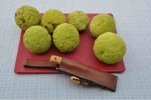
Not bad for a smaller blade
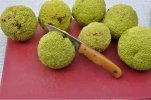
Seeds and sap. Beware, it dries and then you need to use Gojo to get rid of it
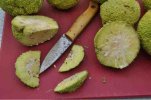
One bonus for the trackers in the forum. However, this one lived 130 million years ago...
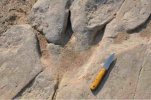
Enjoy,
G
We are about to reach that time in the Summer when the fruits of the Osage Orange start dropping on the ground. So as promised, here are some pictures
A representative sample of a number of horse apples

Not bad for a smaller blade

Seeds and sap. Beware, it dries and then you need to use Gojo to get rid of it

One bonus for the trackers in the forum. However, this one lived 130 million years ago...

Enjoy,
G
Hello all,
With a nice change in the weather, I was able to enjoy a long hike in this weekend. I took the opportunity to test my first Scandi grind from Andy (a Recluse, of course), and a new sheath that Rick made for this knife. I am posting a mini review of both below.
First the Recluse.
This particular knife has a tapered tang, and given that the Recluse has a narrower blade than the Bushfiger, it makes for a very light knife. If you are looking for a packable knife, with a longer 4" blade, this one should do nicely. As for the grind, I has able to thinly slice beef jerky with close to no resistance, so I agree that this type of grind is incredibly sharp and slices very well.
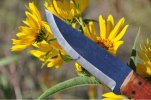
One observation I have for all my tapered handles, is that they tend to run a bit thinner. Andy has stated that he varies handle thickness on purpose, but I have found that most of my full thickness fiddlebacks tend to be thicker. The original specs for the knife are stabilized dyed curly Maple, Scandi on 1/8” thick steel.
Now the sheath.
This is my first sheath by Rick. I am lucky to have a number of sheaths made my Heber, so I decided to also try Rick's design. Rick's sheaths use a different retention mechanism. In the case of the Recluse, most of the friction happens at the "neck" of the knife, just before the blade starts, so I believe this is mostly what retains the knife. The blade also rides tight in the sheath, so there is a good chance that the blade contributes to holding the knife in place. The sheath is thin and compact, so you almost do not know it is there.
I asked Rick to provide a fire-steel and dangler with the sheath. The fire-steel loop is over 2 inches long, so it works better for longer rods. The dangler design is very well executed, since it has two buttons that allow you to slide it over your belt without unbuckling. I hiked for 5 hours with a pack and the sheath, I did not even know it was there.
First a picture of the front. The Recluse sits in the sheath with just the last pin exposed. This makes for fast and secure retrieval of the knife, but at the same time there is plenty of friction to hold it in place as discussed above. I asked Rick to move the fire-loop a bit higher, so 1/3 sits above the end of the stitches on the opposite side.
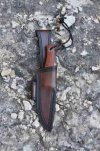
Now the back. Here you can see a square ring that is added before the belt loop is sewn. The ring attaches the dangler to the sheath using the two snap buttons to hold it in place. The top of the dangler is also wider than the base. Note I had the lanyard over the fire-steel loop, to keep it from snagging branches along the way. This is not needed to retain the knife.
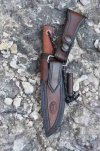
This is how it carries with the dangler.

And now without the dangler. The belt loop allows for changing the angle from vertical as shown.
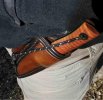
Thank you Andy and Rick for making the knife and the sheath, they will be used quite a bit going forward. I also plan to review Heber's design in detail in the future, since it also works very well. That is all for now,
GM
With a nice change in the weather, I was able to enjoy a long hike in this weekend. I took the opportunity to test my first Scandi grind from Andy (a Recluse, of course), and a new sheath that Rick made for this knife. I am posting a mini review of both below.
First the Recluse.
This particular knife has a tapered tang, and given that the Recluse has a narrower blade than the Bushfiger, it makes for a very light knife. If you are looking for a packable knife, with a longer 4" blade, this one should do nicely. As for the grind, I has able to thinly slice beef jerky with close to no resistance, so I agree that this type of grind is incredibly sharp and slices very well.

One observation I have for all my tapered handles, is that they tend to run a bit thinner. Andy has stated that he varies handle thickness on purpose, but I have found that most of my full thickness fiddlebacks tend to be thicker. The original specs for the knife are stabilized dyed curly Maple, Scandi on 1/8” thick steel.
Now the sheath.
This is my first sheath by Rick. I am lucky to have a number of sheaths made my Heber, so I decided to also try Rick's design. Rick's sheaths use a different retention mechanism. In the case of the Recluse, most of the friction happens at the "neck" of the knife, just before the blade starts, so I believe this is mostly what retains the knife. The blade also rides tight in the sheath, so there is a good chance that the blade contributes to holding the knife in place. The sheath is thin and compact, so you almost do not know it is there.
I asked Rick to provide a fire-steel and dangler with the sheath. The fire-steel loop is over 2 inches long, so it works better for longer rods. The dangler design is very well executed, since it has two buttons that allow you to slide it over your belt without unbuckling. I hiked for 5 hours with a pack and the sheath, I did not even know it was there.
First a picture of the front. The Recluse sits in the sheath with just the last pin exposed. This makes for fast and secure retrieval of the knife, but at the same time there is plenty of friction to hold it in place as discussed above. I asked Rick to move the fire-loop a bit higher, so 1/3 sits above the end of the stitches on the opposite side.

Now the back. Here you can see a square ring that is added before the belt loop is sewn. The ring attaches the dangler to the sheath using the two snap buttons to hold it in place. The top of the dangler is also wider than the base. Note I had the lanyard over the fire-steel loop, to keep it from snagging branches along the way. This is not needed to retain the knife.

This is how it carries with the dangler.

And now without the dangler. The belt loop allows for changing the angle from vertical as shown.

Thank you Andy and Rick for making the knife and the sheath, they will be used quite a bit going forward. I also plan to review Heber's design in detail in the future, since it also works very well. That is all for now,
GM
Last edited:

